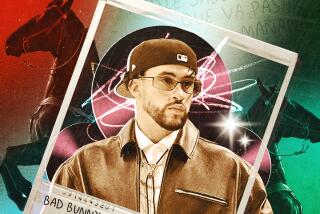Review: Joffrey Ballet returns with reconstructed ‘Rite of Spring’
The celebration of the “Rites” has begun.
“The Rite of Spring” (Le Sacre du Printemps) is the revolutionary 1913 ballet by choreographer Vaslav Nijinsky, composer Igor Stravinsky and artist Nicholas Roerich that clamorously heralded a new age for dance, music and all the arts. The L.A. Music Center and others will spend many months this year marking the 100th anniversary of this 36-minute Ballets Russes juggernaut, which debuted in scandale and now resides secure in the canon. The route from notoriety to eminence may seem random, yet is ever-predictable.
The Joffrey Ballet of Chicago this weekend returned with its “Sacre” to the Dorothy Chandler Pavilion. It was there in 1987 that an eagerly awaited reconstruction of the “lost” ballet debuted. Nijinsky’s original production was performed a mere eight times -- a shockingly brief life span given its reverberations. It was Stravinsky’s disturbing and remarkable score that primarily shook up audiences for the rest of the 20th century.
With the Joffrey as Music Center resident company through 1991, we witnessed “Sacre” annually for five years, then once again in 2003. That last time, patrons could be overheard grumbling about it; this time, the three performances sold out.
The ballet’s geometric choreography, with its devilish rhythmic counterpoint and modernist take on folkloric body shapes, was reconstructed by choreographer and dance scholar Millicent Hodson. Art historian Kenneth Archer worked on costumes and decor.
They did a meticulous detective job of rebuilding this depiction of archaic Slavic rituals and tribes welcoming the Earth’s reawakening. For this viewer, though, its shocking spirit is hard to feel; perhaps that’s gone forever. At Saturday evening’s performance, which was marked by minor gaffes and a cautious depiction, it inspired respectful admiration.
The sacrifice of the maiden, however, with its dance to the death, conjures genuine primal fear. Nijinsky’s circling maidens, expressionless Kewpie dolls with powdered faces and tilted heads, await the horrifying sign of the Chosen One. When she falls, they swiftly turn on her, leaving one of their own to an inevitable, barbaric demise.
As the Chosen One, Elizabeth Hansen gave in to the feral intensity of the trance-induced leaps (more than 100 jumps). Among the other soloists, Erica Lynette Edwards, as the Old Woman, was especially stirring, her disjointed movements charged with spontaneous energy.
Nijinsky’s hand-in-glove treatment of Stravinsky’s bellowing percussions and mournful reedy cries does justice to the score as no other dance version does. The orchestra of local musicians, following the baton of Joffrey Ballet music director Scott Speck, gave a stirringly emotive and committed performance.
Befitting a Joffrey program, the night also featured two very different, contemporary voices. The first was that of Edwaard Liang, a onetime standout soloist with New York City Ballet. In “Age of Innocence” (2008), he matched an undulating, breezy classical vocabulary to selections by Philip Glass and Thomas Newman to create two atmospheres, one repressed, the other unrestrained. Sections of group unisons contrasted with two inventive pas de deuxs, the most stunning a gymnastic feat for Victoria Jaiani and Fabrice Calmels. “Age’s” beauty, however, was largely on the surface. It could have benefited too from more rigorous attention to uniformity.
Jaiani was a star again in William Forsythe’s seminal “In the Middle, Somewhat Elevated” (1987), the other once-radical offering, danced to an assaultive electronic recording by Thom Willems. Forsythe makes ballet hard, no-nonsense, haughty -- and spectacular. Amber Neumann and Ricardo Santos were particularly fearless, stretching shapes and articulating rhythms to extremes.
Maybe that’s the bottom line -- the quest for new art is ageless and thrilling to witness.
MORE
INTERACTIVE: Christopher Hawthorne’s On the Boulevards
VOTE: What’s the best version of ‘O Holy Night’?
PHOTOS: Arts and culture in pictures
More to Read
The biggest entertainment stories
Get our big stories about Hollywood, film, television, music, arts, culture and more right in your inbox as soon as they publish.
You may occasionally receive promotional content from the Los Angeles Times.






